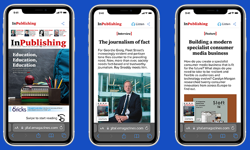1. Why I don’t like the ‘newsstand’ (Victoria Scott, Readers Digest)
The newsstand is like a big hole in the floor, through which you dump copies, 45% of which are wasted. The effort, compared to the return, is a nightmare. Retailers hold all the cards. Who will have the next range review? Who will be the next to threaten a delisting? And how many of us feel we pay twice for merchandising? We pay people to put it out, and then we pay people to check that it’s been put out! Our sales are more vulnerable to market conditions (too hot, too cold, leaves on the line) and we’re locked into a covermount trap that means we’re giving away tat that even her eight year old daughter would turn her nose up at.
2. Using PR to boost profile (Victoria Scott)
One thing newsstand does deliver is high visibility. Readers Digest compensates for their minimal newsstand presence with a very pro-active PR strategy. "We get more column inches than any other magazine!" One recent high profile story was their poll to find ‘Britain’s most trusted personality’ and this was picked up widely by the press. (In case you missed it, it was David Attenborough.)
3. Evolving publishing models (All speakers!)
One of the greatest changes for publishers is that we are starting to look at the customer as being the centre of the universe. It is no longer ‘us, us, us’. Push is changing to pull, or to put it another way, the ‘outside-in model’, where consumers are taking control. The task of publishers is to, Arctic Monkeys like, get into that inner circle of recommendation.
4. Surprising how few publishers have DM expertise (Chris Spratling, Future Publishing)
Especially at senior level! Few publishers have a central data strategy, a standard approach to data capture and any real idea of how much data there is swilling around their business. And – don’t get too carried away when you find the proverbial box of competition entries under your desk, since, without the appropriate permission statements, they’re probably useless anyway!
5. Ten golden rules for CRM success (Chris Spratling)
1 Don’t be afraid to admit your virginity. 2 Find the right partners and recruit the right team. 3 Have a clear data-centric strategy. 4 Ensure executive level buy-in. 5 Have a detailed project plan. 6 Never underestimate the internal hurdles / ignorance. 7 Never compromise on the issue of data hygiene. 8 Quantify the benefits and objectives. 9 Highlight the quick wins. 10 Don’t be afraid to learn along the way.
6. Essential elements of a marketing database (Andy McKnight, Broadsystem)
First and foremost, relevant data! But, beyond that, you need to have a good idea of what the ‘ideal’ record looks like * Full communication history – how many times you have communicated with your prospects, the nature of each communication and how they responded. "It amazes me how few publishers keep this information." * Combination of private information (info they have given you) and public (from other sources) * Processes for validating, cleaning and loading data * De-duplication capabilities to create a true single view of the customer * Tools for working with the data * Tools for analysing the data * But, when all is said and done, the most important part is "how you act on the data."
7. Know your systems and processes (Jenny Moseley)
Today’s emphasis on data and online marketing, makes it more important than ever that publishers know their systems. No, not the technical coding, but the system functionality. What does the system do when X happens? If you use a bureau, then spend time with them, and not just with the management. Sit down with the customer service and data input operators to see how they are processing your customers / data.
8. Test, Test, Test (Jenny Moseley)
"One of my pet hates is that there is not enough testing. People are ‘too busy’ to test! Yet, only by testing and validation, can you achieve your goals, and the vehicle for proper testing is the clever use of data." Jenny had some tips for effective testing: test no less than 15% * don’t test so much that you skew results (test one thing at a time) * Ensure that the sample size is statistically valid * Be sure your figures are sound * Don’t jump to the conclusion you want (lies, damned lies and …) * Validate around 25% before you roll out.
9. Consistent data protection policy (Jenny Moseley)
Do you know the value of a name? Or, more to the point, do you know the difference in value between a name collected with appropriate permissions and a name collected without them? A lack of company wide guidance on permissioning strategy can seriously reduce your universe of marketable names. Jenny has seen many instances of usable names being secured through correct communications by one division in a company, only to be undone by incorrect or ‘overly compliant’ communications with that same customer by another part of the company. She has also found numerous examples of companies using differently worded permission statements online and offline. There is a real risk of companies destroying their business from the bottom up!
10. Is this the future? (Jenny Moseley)
And finally – for a nightmarish vision of the future, open: www.aclu.org/pizza/images/screen.swf










